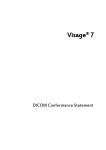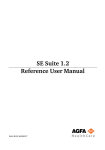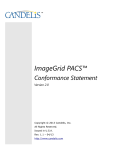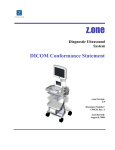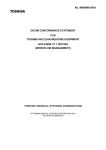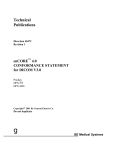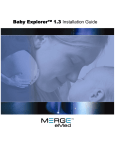Download DICOM Conformance Statement for Cedara CR
Transcript
Document Number: 2008-01503 Revision: 2.0 March 12th, 2009 DICOM Conformance Statement for Cedara CR Console Manager™ Product Version 1.1 Copyright © 2009 by Merge Healthcare Cedara CR Console Manager 1.1 - DICOM Conformance Statement Overview This document describes the DICOM v3.0 implementation supported by Cedara CR Console Manager™ 1.1. It documents conformance aspects required to interoperate with other DICOM v3.0 conformant devices. The Cedara CR Console Manager implements the necessary DICOM services to download work lists from an information system and save acquired CR images to a network storage device and/or local Cedara I-View storage device. Table 1 lists the Supported Networking DICOM Service (SOP) Classes. SOP Classes User of Service (SCU) Transfer Computed Radiography Image Storage Yes 1.2.840.10008.5.1.4.1.1.1 Workflow Management Storage Commitment Push Model Yes 1.2.840.10008.1.20.1 Modality Worklist Information Model Yes FIND 1.2.840.10008.5.1.4.31 Provider of Service (SCP) No No No Table 1. Network Services 2 Revision 2.0 Cedara CR Console Manager 1.1 - DICOM Conformance Statement Table of Contents Overview............................................................................................................................. 2 Table of Contents................................................................................................................ 3 1. Introduction..................................................................................................................... 5 1.1 Revision History ....................................................................................................... 5 1.2 Audience ................................................................................................................... 5 1.3 Remarks .................................................................................................................... 5 1.4 Terms And Definitions ............................................................................................. 6 1.5 Basics of DICOM Communication........................................................................... 8 1.6 Abbreviations............................................................................................................ 9 1.7 References................................................................................................................. 9 2. Networking ................................................................................................................... 10 2.1 Implementation Model............................................................................................ 10 2.1.1 Application Data Flow..................................................................................... 10 2.1.2 Functional definition of AEs............................................................................ 11 2.1.3 Sequencing of Real World Activities .............................................................. 12 2.2 AE Specification ..................................................................................................... 13 2.2.1 Worklist AE Specification ............................................................................... 13 2.2.1.1 SOP Classes .................................................................................................. 13 2.2.1.2 Association Establishment Policies .............................................................. 13 2.2.1.3 Association Initiation Policy......................................................................... 13 2.2.1.4 Association Acceptance Policy..................................................................... 17 2.2.2 Storage AE Specification................................................................................. 17 2.2.2.1 SOP Classes .................................................................................................. 17 2.2.2.2 Association Establishment Policies .............................................................. 17 2.2.2.3 Association Initiation Policy......................................................................... 18 2.2.2.4 Association Acceptance Policy..................................................................... 21 2.3 Network Interfaces.................................................................................................. 21 2.3.1 Physical Network Interface.............................................................................. 21 2.3.2 Additional Protocols ........................................................................................ 21 2.4 Configuration .......................................................................................................... 22 2.4.1 AE Title/Presentation Address Mapping ......................................................... 22 3 Media Interchange ......................................................................................................... 24 4 Support of Extended Character Sets .............................................................................. 25 5 Security .......................................................................................................................... 26 5.1 Security Profiles.................................................................................................. 26 5.2 Association Level Security ................................................................................. 26 5.3 Application Level Security ................................................................................. 26 6 Annexes.......................................................................................................................... 27 6.1 IOD Contents ......................................................................................................... 27 6.1.1 Created CR SOP Instances............................................................................... 27 6.1.2 Usage of Attributes From Received IOD’s...................................................... 29 6.1.3 Attribute Mapping............................................................................................ 29 3 Revision 2.0 Cedara CR Console Manager 1.1 - DICOM Conformance Statement 6.1.4 Coerced/Modified Fields ................................................................................. 29 6.2 Data Dictionary of Private Attributes ..................................................................... 29 6.3 Coded terminology and Templates ......................................................................... 29 6.4 Grayscale Image Consistency ................................................................................. 29 6.5 Standard Extended/Specialized/Private SOP Classes............................................. 29 6.6 Private Transfer Syntaxes ....................................................................................... 29 4 Revision 2.0 Cedara CR Console Manager 1.1 - DICOM Conformance Statement 1. Introduction The Cedara CR Console Manager integrates with the Kodak Point-of-Care CR Reader version 3.0 (Kodak LightQC) to acquire CR images. The console should be connected to the CR Reader for acquisition. The console should be connected to the information network for Modality Worklist, CR Image Storage and/or Storage Commitment. The use of this conformance statement by itself does not guarantee successful interoperability of the product with equipment from other vendors. The user or integrator of Cedara CR Console Manager should keep the following issues in mind: - - - Successful interoperability of the Cedara CR Console Manager with other devices may require functions which are not specified within the scope of DICOM. It is the user’s or integrator’s responsibility to ensure that the proper analysis and validation is performed to verify the connection. Test procedures should be used to verify that data transferred into/from the software is correct. This is often done with the aid of phantom scans using a variety of clinical protocols. Test procedures should be used to verify connectivity. Issues such as power failure and broken connections should be verified. 1.1 Revision History Version 1.0 2.0 Type major minor Date Sept. 11, 2008 March 12th, 2009 Description Initial version Changed logo and product # to 1.1. 1.2 Audience This document is written for the people that need to understand how Cedara CR Console Manager will integrate into their healthcare facility. This includes both those responsible for overall imaging network policy and architecture, as well as integrators who need to have a detailed understanding of the DICOM features of the product. This document contains some basic DICOM definitions so that any reader may understand how this product implements DICOM features. However, integrators are expected to fully understand all the DICOM terminology, how the tables in this document relate to the product’s functionality, and how that functionality integrates with other devices that support compatible DICOM features. 1.3 Remarks The scope of this DICOM Conformance Statement is to facilitate integration between Cedara CR Console Manager and other DICOM products. The Conformance Statement should be read and understood in conjunction with the DICOM Standard. DICOM by itself does not guarantee 5 Revision 2.0 Cedara CR Console Manager 1.1 - DICOM Conformance Statement interoperability. The Conformance Statement does, however, facilitate a first-level comparison for interoperability between different applications supporting compatible DICOM functionality. This Conformance Statement is not supposed to replace validation with other DICOM equipment to ensure proper exchange of intended information. In fact, the user should be aware of the following important issues: - - The comparison of different Conformance Statements is just the first step towards assessing interconnectivity and interoperability between the product and other DICOM conformant equipment. Test procedures should be defined and executed to validate the required level of interoperability with specific compatible DICOM equipment, as established by the healthcare facility. 1.4 Terms And Definitions Informal definitions are provided for the following terms used in this Conformance Statement. The DICOM Standard is the authoritative source for formal definitions of these terms. Abstract Syntax – the information agreed to be exchanged between applications, generally equivalent to a Service/Object Pair (SOP) Class. Examples : Verification SOP Class, Modality Worklist Information Model Find SOP Class, Computed Radiography Image Storage SOP Class. Application Entity (AE) – an end point of a DICOM information exchange, including the DICOM network or media interface software; i.e., the software that sends or receives DICOM information objects or messages. A single device may have multiple Application Entities. Application Entity Title – the externally known name of an Application Entity, used to identify a DICOM application to other DICOM applications on the network. Application Context – the specification of the type of communication used between Application Entities. Example: DICOM network protocol. Association – a network communication channel set up between Application Entities. Attribute – – a unit of information in an object definition; a data element identified by a tag. The information may be a complex data structure (Sequence), itself composed of lower level data elements. Examples: Patient ID (0010,0020), Accession Number (0008,0050), Photometric Interpretation (0028,0004), Procedure Code Sequence (0008,1032). Information Object Definition (IOD) – the specified set of Attributes that comprise a type of data object; does not represent a specific instance of the data object, but rather a class of similar data objects that have the same properties. The Attributes may be specified as Mandatory (Type 1), Required but possibly unknown (Type 2), or Optional (Type 3), and there may be conditions associated with the use of an Attribute (Types 1C and 2C). Examples: MR Image IOD, CT Image IOD, Print Job IOD. Joint Photographic Experts Group (JPEG) – a set of standardized image compression techniques, available for use by DICOM applications. 6 Revision 2.0 Cedara CR Console Manager 1.1 - DICOM Conformance Statement Media Application Profile – the specification of DICOM information objects and encoding exchanged on removable media (e.g., CDs) Module – a set of Attributes within an Information Object Definition that are logically related to each other. Example: Patient Module includes Patient Name, Patient ID, Patient Birth Date, and Patient Sex. Negotiation – first phase of Association establishment that allows Application Entities to agree on the types of data to be exchanged and how that data will be encoded. Presentation Context – the set of DICOM network services used over an Association, as negotiated between Application Entities; includes Abstract Syntaxes and Transfer Syntaxes. Protocol Data Unit (PDU) – a packet (piece) of a DICOM message sent across the network. Devices must specify the maximum size packet they can receive for DICOM messages. Security Profile – a set of mechanisms, such as encryption, user authentication, or digital signatures, used by an Application Entity to ensure confidentiality, integrity, and/or availability of exchanged DICOM data Service Class Provider (SCP) – role of an Application Entity that provides a DICOM network service; typically, a server that performs operations requested by another Application Entity (Service Class User). Examples: Picture Archiving and Communication System (image storage SCP, and image query/retrieve SCP), Radiology Information System (modality worklist SCP). Service Class User (SCU) – role of an Application Entity that uses a DICOM network service; typically, a client. Examples: imaging modality (image storage SCU, and modality worklist SCU), imaging workstation (image query/retrieve SCU) Service/Object Pair (SOP) Class – the specification of the network or media transfer (service) of a particular type of data (object); the fundamental unit of DICOM interoperability specification. Examples: Ultrasound Image Storage Service, Basic Grayscale Print Management. Service/Object Pair (SOP) Instance – an information object; a specific occurrence of information exchanged in a SOP Class. Examples: a specific x-ray image. Tag – a 32-bit identifier for a data element, represented as a pair of four digit hexadecimal numbers, the “group” and the “element”. If the “group” number is odd, the tag is for a private (manufacturer-specific) data element. Examples: (0010,0020) [Patient ID], (07FE,0010) [Pixel Data], (0019,0210) [private data element] Transfer Syntax – A set of encoding rules that allow Application Entities to unambiguously negotiate the encoding techniques (e.g., Data Element structure, byte ordering, compression) they are able to support, thereby allowing these Application Entities to communicate. Examples: JPEG Baseline, Explicit VR Little Endian. Unique Identifier (UID) – a globally unique “dotted decimal” string that identifies a specific object or a class of objects; an ISO-8824 Object Identifier. Examples: Study Instance UID, SOP Class UID, SOP Instance UID. 7 Revision 2.0 Cedara CR Console Manager 1.1 - DICOM Conformance Statement Value Representation (VR) – the format type of an individual DICOM data element, such as text, an integer, a person’s name, or a code. DICOM information objects can be transmitted with either explicit identification of the type of each data element (Explicit VR), or without explicit identification (Implicit VR); with Implicit VR, the receiving application must use a DICOM data dictionary to look up the format of each data element. 1.5 Basics of DICOM Communication This section describes terminology used in this Conformance Statement for the non-specialist. The key terms used in the Conformance Statement are highlighted in italics below. This section is not a substitute for training about DICOM, and it makes many simplifications about the meanings of DICOM terms. Two Application Entities (devices) that want to communicate with each other over a network using DICOM protocol must first agree on several things during an initial network “handshake”. One of the two devices must initiate an Association (a connection to the other device), and ask if specific services, information, and encoding can be supported by the other device (Negotiation). DICOM specifies a number of network services and types of information objects, each of which is called an Abstract Syntax for the Negotiation. DICOM also specifies a variety of methods for encoding data, denoted Transfer Syntaxes. The Negotiation allows the initiating Application Entity to propose combinations of Abstract Syntax and Transfer Syntax to be used on the Association; these combinations are called Presentation Contexts. The receiving Application Entity accepts the Presentation Contexts it supports. For each Presentation Context, the Association Negotiation also allows the devices to agree on Roles – which one is the Service Class User (SCU - client) and which is the Service Class Provider (SCP - server). Normally the device initiating the connection is the SCU, i.e., the client system calls the server, but not always. The Association Negotiation finally enables exchange of maximum network packet (PDU) size, security information, and network service options (called Extended Negotiation information). The Application Entities, having negotiated the Association parameters, may now commence exchanging data. Common data exchanges include queries for worklists and lists of stored images, transfer of image objects and analyses (structured reports), and sending images to film printers. Each exchangeable unit of data is formatted by the sender in accordance with the appropriate Information Object Definition, and sent using the negotiated Transfer Syntax. There is a Default Transfer Syntax that all systems must accept, but it may not be the most efficient for some use cases. Each transfer is explicitly acknowledged by the receiver with a Response Status indicating success, failure, or that query or retrieve operations are still in process. Two Application Entities may also communicate with each other by exchanging media (such as a CD-R). Since there is no Association Negotiation possible, they both use a Media Application Profile that specifies “pre-negotiated” exchange media format, Abstract Syntax, and Transfer Syntax. 8 Revision 2.0 Cedara CR Console Manager 1.1 - DICOM Conformance Statement 1.6 Abbreviations AE AET DHCP DICOM DNS FSC HIS IOD IPv4 IPv6 ISO JPEG MPPS MSPS MTU MWL NTP O OSI PACS PDU R RIS SC SCP SCU SOP SPS SR TCP/IP U UL VR Application Entity Application Entity Title Dynamic Host Configuration Protocol Digital Imaging and Communications in Medicine Domain Name System File-Set Creator Hospital Information System Information Object Definition Internet Protocol version 4 Internet Protocol version 6 International Organization for Standards Joint Photographic Experts Group Modality Performed Procedure Step Modality Scheduled Procedure Step Maximum Transmission Unit (IP) Modality Worklist Network Time Protocol Optional (Key Attribute) Open Systems Interconnection Picture Archiving and Communication System Protocol Data Unit Required (Key Attribute) Radiology Information System. Secondary Capture Service Class Provider Service Class User Service-Object Pair Scheduled Procedure Step Structured Reporting Transmission Control Protocol/Internet Protocol Unique (Key Attribute) Upper Layer Value Representation 1.7 References NEMA PS3 2008 - Digital Imaging and Communications in Medicine (DICOM) Standard, available free at http://medical.nema.org/ 9 Revision 2.0 Cedara CR Console Manager 1.1 - DICOM Conformance Statement 2. Networking This section describes the networking related services of the Cedara CR Console Manager. 2.1 Implementation Model 2.1.1 Application Data Flow DICOM Standard Interface Update Worklist Worklist Application Entity Remote Application Entity Provides Worklist Items Accept Images Remote Application Entity Receives Images Send Images Storage Application Entity Remote Application Entity Commits Images Commit Images 10 Revision 2.0 Cedara CR Console Manager 1.1 - DICOM Conformance Statement The Worklist AE receives Worklist information from a remote AE. It is associated with the “Update Worklist” local real-world activity. When the “Update Worklist” local realworld activity is performed, the Worklist AE queries a remote AE for worklist items and provides the set of worklist items matching the query request. “Update Worklist” is performed as a result of an operator request or can be performed automatically at specific time intervals The Storage AE sends images to a remote AE. The remote AE could be an archive device, PACS or a local installation of Cedara I-View. The Storage AE is associated with the local real-world activities “Accept Images” and “Send Images”. On the “Accept Images” real-world activity, the Storage AE sends images immediately to Cedara I-View (if installed). “Send Images” is activated by user settings (auto-send) and when performed, the Storage AE sends images to all remote AEs. The Storage AE requests Storage Commitment if a remote AE is configured as a storage commitment device. Only one storage commitment device may be active at a time. The Storage AE is associated with the local real-world activity “Commit Images” which is activated by user settings (auto-commit). 2.1.2 Functional definition of AEs 2.1.2.1 Functional Definition of Worklist AE Worklist Update attempts to download a Worklist from a remote node. If the Worklist AE establishes an Association to a remote AE, it will transfer all worklist items via the open Association. The results will be displayed in a list to the user. 2.1.2.2 Functional Definition of Storage AE When an image is acquired and accepted by the user, the application stores the image in its local database and then initiates an archive-queue entry in the local database with the associated network destination. The existence of the archive-queue entry activates the Storage AE. An association request is sent to the destination AE and upon successful negotiation, the image transfer is started. If the association cannot be opened, the related archive-queue entry will be scheduled for the next retry (automatic). If the destination AE is configured as a storage commitment device, and the Storage AE has transferred the image to the destination, a commitment confirmation is requested. If a commitment is successfully confirmed, the Commitment AE will record this information in the local database. 11 Revision 2.0 Cedara CR Console Manager 1.1 - DICOM Conformance Statement 2.1.3 Sequencing of Real World Activities Department Scheduler Worklist Kodak LightQC Query Worklist Receive Worklist Select Worklist item Start Acquisition Acquire Images Storage Archive Accept Images Store Images Request Storage Commitment Image Storage Committed 12 Revision 2.0 Cedara CR Console Manager 1.1 - DICOM Conformance Statement 2.2 AE Specification 2.2.1 Worklist AE Specification 2.2.1.1 SOP Classes The Worklist AE provides Standard Conformance to the following SOP Classes: SOP Class Name SOP Class UID SCU SCP Modality Worklist Information Model – FIND 1.2.840.10008.5.1.4.31 Yes No 2.2.1.2 Association Establishment Policies 2.2.1.2.1 General The DICOM standard application context name for DICOM 3.0 is always proposed: Application Context Name 1.2.840.10008.3.1.1.1 2.2.1.2.2 Number of Associations The maximum number of simultaneous Associations is 1. 2.2.1.2.3 Asynchronous Nature The Worlist AE does not support asynchronous operations and will not perform asynchronous window negotiation. 2.2.1.2.4 Implementation Identifying Information The application uses the following implementation identifying information: - Implementation Class UID: Implementation Version Name: 2.16.124.113531.9 OE ver 1.0 2.2.1.3 Association Initiation Policy This section describes the conditions under which the Worklist AE will initiate an association. 13 Revision 2.0 Cedara CR Console Manager 1.1 - DICOM Conformance Statement 2.2.1.3.1 Activity – Worklist Update A Worklist Update occurs on user interaction (pressing the “Search” button on the Worklist control) or automatically at specific time intervals configurable by the user. To specify query parameters, the user types search criteria in the column headers of the worklist. 2.2.1.3.1.1 Description and Sequencing of Activities Upon initiation of the request, the Worklist AE will build an Identifier for the C-FIND request, will initiate an Association to send the request and will wait for Worklist responses. After retrieval of all responses, the Worklist AE will update the Worklist control with the list of responses. 2.2.1.3.1.2 Proposed Presentation Contexts The Worklist AE will propose Presentation Contexts as shown in the following table. Presentation Context Table Abstract Syntax Name UID Modality 1.2.840.10008.5.1. Worklist 4.31 Information Model – FIND Transfer Syntax Name List UID List Implicit Little 1.2.840.10008.1.2 Endian Role SCU Extended Negotiation None 2.2.1.3.1.3 SOP Specific Conformance for Modality Worklist The behavior of Worklist AE when encountering status codes in a Modality Worklist CFIND response is summarized in the table below. If any other SCP response status that “Success” or “Pending” is received by Worklist AE, a message will appear on the user interface and the user interface will fall back to locally saved worklist items for display. Service Status Success Refused Failed Failed Modality Worklist C-FIND Response Status Handling Behavior Further Error Behavior Meaning Code Matching is 0000 The SCP has completed the matches. complete Worklist items are available for display. Out of A700 The Association is aborted using A-ABORT resources and the worklist query is marked as failed. Error information is logged. Identifier does A900 The Assocation is aborted using A-ABORT not match SOP and the worklist query is marked as failed. Class Error information is logged. Unable to C000 – The Association is aborted using A-ABORT Process CFFF and the worklist query is marked as failed. Error information is logged. 14 Revision 2.0 Cedara CR Console Manager 1.1 - DICOM Conformance Statement Cancel Matching terminated due to Cancel request FE00 Pending Matches are continuing Matches are continuing – Warning that one or more Optional Keys were not supported * FF00 Pending * FF01 Any other status code. If the query was cancelled due to too many worklist items then the SCP has completed the matches. Worklist items are available for display. Otherwise, the Association is aborted using A-ABORT and the worklist query is marked as failed. Error information is logged. The worklist item contained in the Identifier is collected for later display. The worklist item contained in the Identifier is collected for later display. Errors are logged only once for each C-FIND operation The Association is aborted using A-ABORT and the worklist is marked as failed. Error information is logged. The behavior of Worklist AE during communication failure is summarized in the table below. Modality Worklist Communication Failure Behavior Behavior The Association is aborted using A-ABORT and the worklist query marked as failed. The reason is logged. Association aborted by The worklist query is marked as failed. The reason is logged. the SCP or network layers Exception Timeout Acquired images will always use the Study Instance UID specified for the Scheduled Procedure Step (if available). If an acquisition is unscheduled, a Study Instance UID will be generated locally. The table below provides a description of the Worklist AE Worklist Request Identifier and specifies the attributes that are copied into the images. Unexpected attributes returned in a C-FIND response are ignored. Requested return attributes not supported by the SCP are set to have no value. Nonmatching responses returned by the SCP due to unsupported optional matching keys are ignored. No attempt is made to filter out possible duplicate entries. 15 Revision 2.0 Cedara CR Console Manager 1.1 - DICOM Conformance Statement Module Name Worklist Request Identifier Tag VR Attribute Name SOP Common Specific Character Set Scheduled Procedure Step Scheduled Procedure Step Sequence > Scheduled Station AET > Scheduled Procedure Step Start Date > Scheduled Procedure Step Start Time > Modality > Scheduled Performing Physician’s Name > Scheduled Procedure Step Description > Scheduled Station Name > Scheduled Procedure Step ID Requested Procedure Requested Procedure Description Study Instance UID Requested Procedure Priority Imaging Service Request Accession Number Referring Physician’s Name Patient Identification Patient Name Patient ID Patient Demographic Patient’s Birth Date Patient’s Sex Patient’s Weight M R Q D IOD (0008,0005) CS X (0040,0100) SQ X (0040,0001) (0040,0002) AE DA (0040,0003) TM (0008,0060) (0040,0006) CS PN (0040,0007) LO (0040,0010) (0040,0009) SH SH (0032,1060) LO X (0020,000D) UI (0040,1003) SH X X (0008,0050) (0008,0090) SH PN X X X X X X (0010,0010) (0010,0020) PN LO X X X X X X X X (0010,0030) (0010,0040) (0010,1030) DA CS DS X X X X X X X X X S S X S X X X X (S) X X X The above table should be read as follows: Module Name: The name of the associated module for supported worklist attributes. Attribute Name: Attributes supported to build a Worklist AE Worklist Request Identifier 16 Revision 2.0 Cedara CR Console Manager 1.1 - DICOM Conformance Statement Tag: DICOM tag for this attribute VR: DICOM VR for this attribute M: Matching keys for Worklist update. A “S” will indicate that Worklist AE will supply an attribute value for Single Value Matching. R: Return keys. An “X” will indicate that Worklist AE will supply this attribute as Return Key with zero length for Universal Matching. Q: Interactive Query Key. An “X” will indicate that Worklist AE will supply this attribute as matching key, if entered in the Worklist user interface. D: Displayed keys. An “X” indicates that this worklist attribute is displayed to the user during patient registration dialog. IOD: An “X” indicates that this Worklist attribute is included into all Object Instances created during performance of the related Procedure Step. 2.2.1.4 Association Acceptance Policy The Worklist AE does not accept Associations. 2.2.2 Storage AE Specification 2.2.2.1 SOP Classes The Storage AE provides Standard Conformance to the following SOP Classes: SOP Class Name SOP Class UID SCU SCP Computed Radiography Image Storage 1.2.840.10008.5.1.4.1.1.1 Yes No Storage Commitment Push Model 1.2.840.10008.1.20.1 Yes No 2.2.2.2 Association Establishment Policies 17 Revision 2.0 Cedara CR Console Manager 1.1 - DICOM Conformance Statement 2.2.2.2.1 General The DICOM standard application context name for DICOM 3.0 is always proposed: 1.2.840.10008.3.1.1.1 Application Context Name 2.2.2.2.2 Number of Associations The number of simultaneous associations is not limited by the application. As an association initiator the AE creates at most one association per destination at a given time. 2.2.2.2.3 Asynchronous Nature The Storage AE does not support asynchronous operations and will not perform asynchronous window negotiation. 2.2.2.2.4 Implementation Identifying Information The application uses the following implementation identifying information: - Implementation Class UID: Implementation Version Name: 2.16.124.113531.9 OE ver 1.0 2.2.2.3 Association Initiation Policy This section describes the conditions under which the Storage AE will initiate an association. 2.2.2.3.1 Activities – Accept Images and Send Images (Auto-Send) Accept Images occurs on user interaction (pressing the “Exit” button on the Kodak LightQC application). When Accept Images is performed, the Storage AE immediately initates an Association to the I-View Storage SCP and transfers the images to I-View upon successful Association. The transfer to Cedara I-View occurs only if Cedara I-View is installed on the local system and the I-View Storage SCP is configured as a destination AE for the Cedara CR Console Manager Storage AE. The Storage AE may be configured to send output images from Kodak LightQC to destination Storage SCPs at regular intervals. When the Send Images (auto-send) activity is performed, the Storage AE initiates an Association to the archive and transfers the images to the archive upon success. If the association or transfer is not successful, the images are scheduled for transfer at the next auto-send time interval. 2.2.2.3.1.1 Description and Sequencing of Activities The Storage AE will initiate an association to an archive as a Storage SCU and send the images using C-STORE operation. The association is released after all images have been transferred. 18 Revision 2.0 Cedara CR Console Manager 1.1 - DICOM Conformance Statement 2.2.2.3.1.2 Proposed Presentation Contexts The Storage AE will propose Presentation Contexts as shown in the following table. Presentation Context Table Abstract Syntax Name UID CR Image 1.2.840.10008.5.1. Storage – For 4.1.1.1 Presentation Transfer Syntax Name List UID List Implicit Little 1.2.840.10008.1.2 Endian Role SCU Extended Negotiation None 2.2.2.3.1.3 SOP Specific Conformance for CR Image Storage If CR Image Storage SOP Instances are included in the Send Job and a corresponding Presentation Context is not accepted then the Association is aborted using A-ABORT and the send job is marked as failed. The job failure is logged and reported to the user via the Archive Status dialog. The behavior of Storage AE when encountering status codes in a C-STORE response is summarized in the Table below: Service Status Success Refused Error Error Warning Warning Warning * Storage C-STORE Response Status Handling Behavior Further Error Behavior Meaning Code Success 0000 The SCP has successfully stored the SOP Instance. If all SOP Instances in a send job have status success then the job is marked as complete. Out of Resources A700 – The Association is aborted using A-ABORT and the A7FF send job is marked as failed. Error information is logged and the error is reported to the user via the Archive Status UI. Data Set does not A900 – The Association is aborted using A-ABORT and the match SOP Class A9FF send job is marked as failed. Error information is logged and the error is reported to the user via the Archive Status UI. Cannot C000 – The Association is aborted using A-ABORT and the Understand CFFF send job is marked as failed. Error information is logged and the error is reported to the user via the Archive Status UI. Coercion of Data B000 Image transmission is considered successful. Elements Data Set does not B007 Image transmission is considered successful. match SOP Class Elements B006 Image transmission is considered successful. Discarded * Any The Association is aborted using A-ABORT and the other send job is marked as failed. Error information is status logged and the error is reported to the user via the code Archive Status UI. 19 Revision 2.0 Cedara CR Console Manager 1.1 - DICOM Conformance Statement The behavior of Storage AE during communication failure is summarized in the table below. Exception Timeout Association aborted by the SCP or network layers Storage Communication Failure Behavior Behavior The Association is aborted using A-ABORT and the send job is marked as failed. Error information is logged and the error is reported to the user via the Archive Status UI. The send job is marked as failed. The reason is logged and the job failure is reported to the user via the job control application A failed send job is automatically re-started. The delay between resending failed jobs is configurable. 2.2.2.3.2 Activity - Storage Commitment 2.2.2.3.2.1 Description And Sequencing of Activities Whenever a CR image is successfully sent to the archive the Storage AE automatically initiates a new association with the archive as a Storage Commitment SCU and sends an N-ACTION command to request storage commitment for the CR image. Upon receiving the N-ACTION response, the Storage AE releases the association. The Storage AE always listens for connections from the archive on a pre-configured port for storage commitment response. When the archive completes the storage commitment of one or more images it will connect to the Storage AE, request an association and send the appropriate storage commitment result notifications. The Storage AE will store the result of the storage commitment operation for each image. The storage commitment functionality of the Storage AE can be turned off through configuration. 2.2.2.3.2.2 Proposed Presentation Contexts The Storage AE will propose Presentation Contexts as shown in the following table. Presentation Context Table Abstract Syntax Name UID Storage 1.2.840.10008.1. Commitment 20.1 Push Model Transfer Syntax Name List UID List Implicit Little 1.2.840.10008.1.2 Endian Role SCU Extended Negotiation None 2.2.2.3.2.3 SOP Specific Conformance for Storage Commitment Push SOP Class If the association with the archive fails the Storage AE logs an error message describing the error and will not retry. If an N-ACTION response has a status that is not Success the Storage AE will log an error message, close the association and will not attempt to commit the image again. The Storage AE will continue to send storage commitment requests for subsequent CR images. 20 Revision 2.0 Cedara CR Console Manager 1.1 - DICOM Conformance Statement The Storage AE supports an “Association Timer” for each association request. This timer starts when the association request is sent and stops when the association response is received or an error occurs. If a timeout occurs the connection is closed and the association is marked as failed. The Association Timer value is not configurable and it has a default value of 30 seconds. 2.2.2.4 Association Acceptance Policy The Storage AE will accept associations in order to receive responses to a Storage Commitment Request. 2.3 Network Interfaces 2.3.1 Physical Network Interface The Cedara CR Console Manager supports a single network interface. One of the following physical network interfaces will be available depending on installed hardware options: - - Ethernet 100baseT Gigabit Ethernet 2.3.2 Additional Protocols The Cedara CR Console Manager conforms to the System Management Profiles listed in the Table below. All requested transactions for the listed profiles and actors are supported. Support for optional transactions are listed in the following table: Profile Name Network Address Management Actor DHCP Client DNS Client Protocols Used DHCP DNS Optional Transactions N/A N/A Security Support 2.3.2.1 DHCP DHCP can be used to obtain TCP/IP network configuration information. The network parameters obtainable via DHCP are shown in the Table below. The Default Value column of the table shows the default used if the DHCP server does not provide a value. Values for network parameters set in the Service/Installation tool take precedence over values obtained from the DHCP server. Support for DHCP is pre-configured on the system. If DHCP is not in use, TCP/IP network configuration information must be manually configured via the service interface. DHCP Parameter Default Value IP Address Host Name Requested machine name None 21 Revision 2.0 Cedara CR Console Manager 1.1 - DICOM Conformance Statement List of NTP servers List of DNS servers Empty list Empty list Empty list Routers Static Routes None None Domain name Subnet Mask Broadcast address Derived from IP Address (see service manual) Derived from IP Address (see service manual) Default Router Time Offset MTU Auto-IP permission None Site configurable (from Time Zone) Network Hardware Dependent No permission If the DHCP server refuses to renew a lease on the assigned IP address all active DICOM Associations will be aborted. 2.3.2.2 DNS DNS can be used for address resolution. If DHCP is not in use or the DHCP server does not return any DNS server addresses, the identity of a DNS server can be configured in the system via the service interface. If a DNS server is not in use, local mapping between hostname and IP address can be manually configured via the service interface. 2.3.3 IPv4 and IPv6 Support This product only supports IPv4 connections. 2.4 Configuration 2.4.1 AE Title/Presentation Address Mapping 2.4.1.1 Local AE Titles The Cedara CR Console Manager uses the Worklist AE Title/ Storage AE Title and their TCP/IP Ports configured via the service page interface. The Field Service Personnel can configure the TCP Ports via the service page interface. No Default AE Title is provided. The AE Titles must be configured during installation. 2.4.1.2 Remote AE Title/Presentation Address Mapping The AE Title, host names and port numbers of remote applications are configured using the service page interface. 2.4.2 Parameters A number of parameters related to DICOM communication can be configured using preference and config files. The following table shows those configuration parameters relevant to DICOM 22 Revision 2.0 Cedara CR Console Manager 1.1 - DICOM Conformance Statement communication. See the Cedara CR Console Manager Service Manual for details on configuration capabilities. Parameter Max. Send and Receive PDU Size (larger PDUs will never be sent, even if the receiver supports a larger Max PDU Receive Size. If the receiver supports a smaller Max PDU Receive Size then the Max PDU Send Size will be reduced accordingly for the duration of the Association. Max PDU Receive Size information is exchanged during DICOM Association Negotiation in the Maximum Length Sub-Item of the A-ASSOCIATION-RQ and A-ASSOCIATE-AC) Association Timeout and Inactivity Timeout (Time-out waiting for a response to an Association Request or to a release request, Time-out waiting for completion of a TCP/IP connect request, Time-out for waiting for data between TCP/IP-packets) Supported Transfer Syntaxes (separately set for each service) Worklist Auto Update Interval (Automatic worklist update request) Storage Retry Time (How long before resending a failed storage job) Storage Commitment Enabled (Request storage commitment after successful CSTORE response) 23 Configurable (Yes/No) No Default Value No 30 seconds No Implicit VR Little Endian Yes 5 minutes Yes 1 minute Yes Off 65536 Revision 2.0 Cedara CR Console Manager 1.1 - DICOM Conformance Statement 3 Media Interchange Cedara CR Console Manager does not support Media Storage. 24 Revision 2.0 Cedara CR Console Manager 1.1 - DICOM Conformance Statement 4 Support of Extended Character Sets Cedara CR Console Manager only supports the default DICOM character repertoire. 25 Revision 2.0 Cedara CR Console Manager 1.1 - DICOM Conformance Statement 5 Security 5.1 Security Profiles Cedara CR Console Manager does not support any specific security measures. It is user’s responsibility to use the system within a secured environment and to maintain a secured environment that includes at a minimum: - Firewall or router protections to ensure that only approved external hosts have network access to the system Firewall or router protections to ensure that the system only has network access to approved external hosts and services Any communication with external hosts and services outside the locally secured environment use appropriate secure network channels (e.g. such as a Virtual Private Network (VPN)) 5.2 Association Level Security None supported. 5.3 Application Level Security The service page user interface, that is used to configure the DICOM service, is password controlled. 26 Revision 2.0 Cedara CR Console Manager 1.1 - DICOM Conformance Statement 6 Annexes 6.1 IOD Contents Cedara CR Console Manager supports sending of CR images generated by Kodak LightQC. 6.1.1 Created CR SOP Instances The following tables use a number of abbreviations. The abbreviations used in the “Presence of Value” column are: VNAP ANAP ALWAYS EMPTY Value Not Always Present (attribute sent zero length if no value is present) Attribute Not Always Present Always Present Attribute is sent without a value The abbreviations used in the “Source” column: USER AUTO MWL CONSOLE CONFIG the attribute value source is from User input the attribute value is generated automatically by Kodak LightQC the attribute value is from MWL the attribute value is from Cedara CR Console Manager the attribute value source is a configurable parameter Attributes of the CR Image SOP Instances: Attribute Name Tag VR Value Presence of Value ALWAYS ALWAYS Source SOP Class UID SOP Instance UID 0008,0016 0008,0018 UI UI “1.2.840.10008.5.1.4.1.1.1” A unique UID for every new instance of image Study Date Study Time Accession Number Modality Manufacturer Institution Name Referring Physician's Name Station Name Study Description Performing Physician’s Name Operator’s Name Manufacturer’s Model Name Patient’s Name 0008,0020 0008,0030 0008,0050 DA TM SH ALWAYS ALWAYS VNAP ALWAYS ALWAYS ALWAYS VNAP AUTO AUTO USER or MWL AUTO AUTO AUTO AUTO 0008,0060 0008,0070 0008,0080 0008,0090 CS LO LO PN 0008,1010 0008,1030 0008,1050 SH LO PN ALWAYS ANAP ANAP AUTO AUTO AUTO 0008,1070 0008,1090 PN LO ALWAYS ALWAYS AUTO AUTO 0010,0010 PN VNAP USER or “CR” 27 AUTO AUTO Revision 2.0 Cedara CR Console Manager 1.1 - DICOM Conformance Statement Patient ID 0010,0020 LO VNAP Patient's Birth Date Patient's Sex 0010,0030 DA VNAP 0010,0040 CS VNAP 0018,0015 CS ALWAYS MWL USER or MWL USER or MWL USER or MWL AUTO 0018,1004 0018,1164 LO DS ALWAYS ALWAYS AUTO AUTO 0018,1405 IS ALWAYS AUTO 0018,5100 0018,5101 0018,6000 0020,00D CS CS DS UI ALWAYS ALWAYS ALWAYS ALWAYS 0020,000E UI ALWAYS AUTO AUTO AUTO CONSOLE or MWL AUTO 0020,0010 0020,0011 0020,0013 0020,0020 SH IS IS CS Length = 0 ALWAYS ALWAYS ALWAYS ALWAYS AUTO AUTO AUTO AUTO 0020,0060 0028,0002 0028,0004 CS US CS Length = 0 1 “MONOCHROME2” ALWAYS ALWAYS ALWAYS AUTO AUTO AUTO 0028,0010 0028,0011 0028,0030 0028,0034 US US DS IS “1\1” ALWAYS ALWAYS ALWAYS ALWAYS AUTO AUTO AUTO AUTO 0028,0100 0028,0101 0028,0102 0028,0103 US US US US 16 12 11 0 ALWAYS ALWAYS ALWAYS ALWAYS AUTO AUTO AUTO AUTO 0028,0106 US ALWAYS AUTO 0028,0107 US ALWAYS AUTO 0028,1050 0028,1051 0028,1052 0028,1053 0028,1054 DS DS DS DS LO ALWAYS ALWAYS ALWAYS ALWAYS ALWAYS AUTO AUTO AUTO AUTO AUTO Body Part Examined Plate ID Imager Pixel Spacing Relative X-Ray Exposure Patient Position View Position Sensitivity Study Instance UID Series Instance UID Study ID Series Number Instance Number Patient Orientation Laterality Samples Per Pixel Photometric Interpretation Rows Columns Pixel Spacing Pixel Aspect Ratio Bits Allocated Bits Stored High Bit Pixel Representation Smallest Image Pixel Value Largest Image Pixel Value Window Center Window Width Rescale Intercept Rescale Slope Rescale Type Length = 0 A UID is automatically generated for every instance A UID is automatically generated for every instance Length = 0 0 1 “US” 28 Revision 2.0 Cedara CR Console Manager 1.1 - DICOM Conformance Statement Pixel Data 7FE0,0010 OW ALWAYS AUTO 6.1.2 Usage of Attributes From Received IOD’s The Cedara CR Console Manager maintains a list of study, that contains patient and study level attributes, in the database for image viewing. 6.1.3 Attribute Mapping The Cedara CR Console Manager does not perform any attribute mapping. 6.1.4 Coerced/Modified Fields The Cedara CR Console Manager sends IOD generated by Kodak LightQC and does not modify fields. 6.2 Data Dictionary of Private Attributes No private attributes are defined. 6.3 Coded terminology and Templates Code Meaning values are not interpreted or displayed by the application. 6.4 Grayscale Image Consistency The Cedara CR Console Manager does not support the Grayscale Standard Display Function. 6.5 Standard Extended/Specialized/Private SOP Classes The Cedara CR Console Manager does not claim conformance to any Extended, Specialized or Private SOP Classes. 6.6 Private Transfer Syntaxes The Cedara CR Console Manager does not employ any Private Transfer Syntaxes. 29 Revision 2.0






























